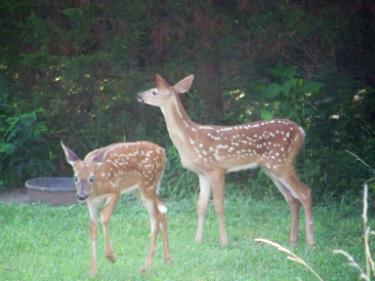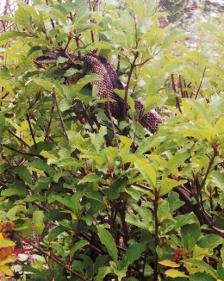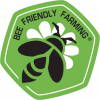HABITATI GARDENING
"We abuse the land because we regard it as a commodity belonging to us. When we see land as a community to which we belong, we may begin to use it with love and respect."
--Aldo Leopold, American conservationist
Specialized relationships between animals and plants are the norm in nature rather than the exception.
The Real Cost of Lawns
An organic lawn area an be wonderful for frolicking children, but those large, "well-maintained" areas of verdure generally are the landscaping equivalents of gas guzzlers parked in the driveway. Consider the following:
1. Lawn mowing uses 300 million gallons of gas and takes about 1 billion hours annually.
2. SafeLawns.org estimates that Americans spend $5.25 billion on petroleum-based lawn fertilizers and $700 million on lawn pesticides annually.
3. According to the EPA, running the average gas- powered lawn mower for 1 hour can create the same amount of pollution as driving a car 340 miles.
4. Nationwide, home landscape irrigation accounts for allmost one-third of all residential water use--more than 7 billion gallons a day Lawns gulp more than half of that.
SOURCE: Natural Home & Garden September/October 2011 pg 28 Garden How To
T
1. Lawn mowing uses 300 million gallons of gas and takes about 1 billion hours annually.
2. SafeLawns.org estimates that Americans spend $5.25 billion on petroleum-based lawn fertilizers and $700 million on lawn pesticides annually.
3. According to the EPA, running the average gas- powered lawn mower for 1 hour can create the same amount of pollution as driving a car 340 miles.
4. Nationwide, home landscape irrigation accounts for almost one-third of all residential water use--more than 7 billion gallons a day. Lawns gulp more than half of that.
SOURCE: Natural Home & Garden September/October 2011 pg 28 Garden How To
Whether granite countertops, a custom kitchen island, or built-in wine cabinets are new kitchen musts, discover thousands of kitchen designs to help make your dream come true.
Collect and share photos of tile, bathroom cabinets, bath linens and a bathroom mirror to create your perfect home decorating style.
Before starting a bathroom remodel, search for bathroom ideas and interesting products, including a one-of-a-kind tub, vanity and bathroom sink.
From wallcovering to a stencil, fabric to room dividers, design doesn't stop at construction.
Filter by metro area and choose the right kitchen designer for your kitchen style.
Select patio furniture to match your style, designer garden sheds or even a greenhouse to personalize your landscape.
Discover inspring landscaping ideas and find a top local landscape contractor or residential landscape architect to plan your garden landscape.
Select patio furniture to match your style, designer garden sheds or even a greenhouse to personalize your landscape.
Whether granite countertops, a custom kitchen island, or a built-in wine rack are new kitchen musts, discover thousands of kitchen designs to help make your dream come true.
Find a wall shelf, customizable closet organization and stylish furnishings to whip your closet into shape.
ARTICLES AND PUBLICATIONS
HABITAT GARDENING
7 Tips for Providing Better Bird Habitat
Improving Pollinator Health Requires Collaboration, Public-Private Partnerships
Indiana, Kentucky and Ohio Wild Berries & Fruits Field Guide by Teresa Marrone This book is written with the forager in mind, and especially for foragers interested in taking home their finds and using them in recipes and in the kitchen.
Journey North: Monarch Butterfly Life Cycle
Keeping Birdseed Fresh and Safe With These Storage Tips
Keep it simple...try this from Oldham County Soil and Water Conservation District.pdf
Kentucky Forest Trees - How to Know Them
Kentucky's Native Alternatives to Invasive Plants
Monarchs, milkweed and the spirit of Rachel Carson
Nonnativve plants: Ecological Traps - National Wildlife Federation
Pollinators - Putting Food on the Table
State of North America's Birds 2016
07/28/2012 The Sound of a Damaged Habitat by Bernie Krause
Tips from Tallamy on Curb Appeal by Suzanne Dingwell
Pocket Field Guide Recognizing Beneficial Insects in the Yard Louisville Water Company.pdf
Pocket Field Guide to Kentucky's Common Weeds and Other Unwanted Plants Louisville Water Copany.pdf
Pocket Field Guide to Kentucky's Wildflowers and Native Grasses Louisville Water Company.pdf
KENTUCKY PARKS
Kentucky Vacations in our own Backyard.pdf
State Parks in Eastern Kentucky.pdf
NON-NATIVE PLANTS
KY-EPPC was established in 2000 as a non-profit organization. KY-EPPC is a state chapter of SE-EPPC whose purpose is:
- To raise awareness and promote public understanding regarding the threat posed by invasive exotic pest plants to native plant communities in Kentucky.
- To facilitate the exchange of information concerning the management and control of invasive exotic pest plants through support of research and monitoring.
- To serve as an educational, advisory and technical support resource on exotics in Kentucky.
- To initiate actions to protect Kentucky from the introduction, establishment and spread of invasive exotics.
- To provide a forum for all interested parties to participate in meetings, workshops, and on a rotational basis with other chapters, host a symposium for the SE EPPC to share the benefits from the information provided by SE EPPC and other recognized experts.
PERMACULTURE
TICKS AND DISEASE Q&A
Rocky Mountain Spotted Fever (RMSF)
Ticks and Disease Answers to Often Asked Questions.pdf
Two Species of Ticks Active During Kentucky Winters
10/08/2012 Take Precautions to Protect Against Ticks, Lyme Disease
WEBSITES
Ladybird Johnson Wildflower Center This is a great resource for plant information.
Monarch Watch Declining Monarch butterfly count details.
US Forest Service Ethnobotany is the study of how people of a particular culture and region make use of indigenous (native) plants.

We have deer on the property continually; however,we do not experience any significant damage to our plant material and in particular to our production beds. Since we are GAP certified we must keep all production beds surrounded by fencing and in our case it is electric fencing which works very well for us in keeping the deer out of the production crops. Below you will find a link to a pdf which covers deer resistant plants. Dogs do an excellent job of deterring deer.
Photo taken 07/03/2007 shed side of property woodland edge.
OTHER
Japanese Bloodgrass New Invasive Plant Identified.pdf
Kentucky Exotic Pest Plant Council. This link provides information detailing exotic plant species which possess characteristics of invasive species and spread easily into native plant communities and displace native vegetation.

Rat Snake
Species Name: Elaphe obsoleta
Non-Venomous
KSNPC status is: Unlisted
Appearance: Adults can reach 6' in length. Coloration is variable but most often is dark gray with darker blotches although they can be almost completely black with indistinguishable blotches. Young almost always are gray with dark blotches.
Notes: Perhaps one of the most common snakes in Kentucky. Lives in a variety of habitats including old buildings where they hunt for mice. Excellent climber that eats rodents, birds and bird eggs, lizards.
Photo taken 07/29/2005 in my Lilac bush. This is a snake you want on your property.
CREATING A HEALTHY YARD
SOURCE: An Invitation to a Healthy Yard by Audubon and the Natural Resources Conservation Service, an agency of the U.S. Department of Agriculture.
Yards are personal havens for recreation, rest, and relazation. By adopting a few basic principles, your yard can become a sanctuary for wildlife as well. As you creat habitat that supports birds, butterflies, and toher wildlife, you also ensure that your yard remains healthy for you and your family. An by learning about the plants and animals native to your area, you renew your connection with the natural world.
Birdscaping--providing food, water, protective corer, and nesting sites for birds--offers a lifetime of learning, excitement, and entertainment while helping local bird populations. Over 650 bird species nest in Norht America, and a birdscaped yard can connect you with dozens of local resident birds and many additional migratory species that will stop by as they travel across the hemisphere. Many backyard birds are summer visitors that spend their winters in Central America and South America, while others are winter visitors that spend their summers in northern boreal forests. Birdscaping can help to ensure the survival of the many individuals that winter, nest, or migrate through your area each year.
While bird feeders and a source of water will easily attract the more common bird species to your yard, the best way to attract and help most birds is to plant native trees, shrubs, and wildflowers. These plants provide the nesting, roosting, and foraging opportunities that your local birds need, and can help to replace natural habitats destroyed, degraded, and fragmented by development. Consult with your local NRCS office to identify native plants suited to the local soil condition. For more inforamtion on how to attract and help the birds in your are, visit Audubon.
Bats are an often overlooked part of our local environment. In the United States, 47 bat species inconspicuously patrol the night skies. Many can consume 30-50 percent of their body weight in insects each night. Since some species can devour up to 600 mosquitoes or other insects each hour, bats are an important part of a natural insect control system. Other bats eat fruit and nectar and play on important role inpollinating native plants and dispersing seeds. Contrary to popular opinion, bats are not aggressive and they do not play a significant role in transmitting rabies to humans. To invite these sophisticated creatures to your yard, you can install a bat house at a height of at least 10 feet on a structire that faces the morning sun.
Butterflies can be persuaded to visit a yard of nay size. Over 700 butterfly species inhabit the United States, and local species will visit your yard if you invite them by planting appropriate flowering plants as food for the adults, and additional vegetation as host plants for their eggs and the caterpillars. Some butterfly species are declining in number due to pesticide use, habitat loss, or unusual climate conditions; providing the appropriate plants for these species may help them to recover.
Bees that pollinate native plants do not necessarily live together in hives. Many of these native solitary bees are declining, but you may be able to help them by building a bee box. Simply drill small holes into an untreated block of wood, or tie a bundle of dried stems together and place them outdoors. Solitary bees will lay their eggs in the holes, which then serve as a nursery.
BEAUTIFULLY BRIDGING THE BARRENS
SOURCE: Native Gardener's Companion Spring 2013 pg 2 http://www.prairiemoon.com/catalog-download/
Unlike some of the grim global challenges that seem to dwarf individual hopes or abilities, Colony Collapse Disorder and Vanishing Bee Syndrome are among the few that can be met on a small scale. Each of us can make choices around our own homes to restore habitat for endangered pollinator while beautifying our own lives and surroundings.
While much concern has been focused on threats to honey bees, environmental stresses also are having negative impacts on populations of native insects, including what remain of the nearly 4,000 species of bees that were native to the continent when honey bees were introduced from Europe in 1622.
More than helpers in our gardens, pollinators (including bees, butterflies, hummingbirds, moths, flies, wasps and even some beetles and bats) are essential for the reporduction of almost 70% of the world's flowering plants. Global food crops rely on winged pollinators, linking their survival to ours. Our native pollinators, having evolved with our native plants, including grains and vegetables, are more efficient partners in those species' life cycles than honey bees. Bumble bees are often among the first flying insects in the spring and the last in the fall, working the plants that bloom only at those times.
The expansion of monoculture farming, cities, suburbs and their infrastructures have destroyed diveres natural habitats, jeopardizing pollinators. Other threats include parasites, pathogens and the proliferating use of pesticides.
Relief from these stressors can be supplied by planting a variety of native wildflowers and grasses, helping to create islands of diverse food sources, stepping stones of habitat, backyard bridges between barrens. Sch healthy ecosystems not only benefit pollinators, they support other beneficial insects that feed on crop pests, naturally replacing pesticides. The reasons for including native plants in our home landscape are many and grand. If we want to keep it simple, though, we need look no further than their beauty, hardiness, variety and adaptability. Though creatures from the soil to the sky will silently thank us by thriving, the presence of native plants in our lives is its onw reward.
SOURCE: An Invitation to a Healthy Yard by Audubon and the Natural Resources Conservation Service, an agency of the U.S. Department of Agriculture.
- Tree cavities can be difficult for nesting birds to find in many developed areas. BIRDHOUSES offer a good alternative. Chickadees, titmice, wrens, and even screech-owls are some of the birds that might take up residence in appropriately sized nest boxes.
- Carefully placed BIRD FEEDERS provide opportunities to watch birds at close range. Different feeders are designed for different seeds, so choose appropriate seeds and feeders for the birds in your area.
- NATIVE PLANTS, including trees, shrubs, and groundcover, create multiple layers of attractive habitat for birds and beneficial insects. Plant shrubs in a way that best mimics natural habitat, and use them around the foundation of your home and the borders of your yard.
- A source of WATER, such as a well maintained birdbath or small pond, will attract birds and beneficial insects such as butterflies. Shallow edges allow birds to bathe and drink without getting too wet.
- Hummingbirds may be attracted to a HUMMINGBIRD FEEDER, especially when the feeder is placed among red or yellow tube shaped wildflowers.
- A BUTTERFLY" GARDEN of native wildflowers, including plants that provide food for caterpillars, will attract a host of winged jewels to your yard.
- A BAT HOUSE mounted on your house may provide an important roosting site for these nocturnal insect hunters.
- An estimated 1 billion birds die each year from crashing into windows. Decorate the outside surface of your WINDOWS to make the glass visible to birds, or install screens as a barrier to keep them at a distance.
- CATS kill millions of birds and other native animals each year. Keep your cat indoors to protect birds, as well as to keep your cat safe and healthy
http://www.nrcs.usda.gov/wps/portal/nrcs/site/national/home/
KEEPING IT REAL
Understanding the difference between "wildflowers" and authentic native plants
Most people correctly understand "wildflowers" to be those that grow freely, without human intervention. However, the poor quality of the "wildflower" seed mixes now being offered in big-box stores and some garden catalogs prompts us to warn, "DON'T PLANT WILDFLOWERS."
Most of the "wildflower" mixes created to meet popular demand are, in fact, not good for wildlife or the environment. Most contain Asian or European flowers which crowd out plants that are truly native to North America. This degrades the environment and displaces the native sources of food and shelter upon which birds, butterflies and other wildlife depend.
Learn more about the importance of true North American native wildflowers from a local nature center, The Nature Conservancy or other natural resource professional.
As your native garden flourishes, providing much-needed food and habitat and beautiful blossoms, you can observe first-hand the critical link between native plants and native wildlife.
SOURCE: Native Gardener's Companion Spring 2014 Prairie Moon Nursery


